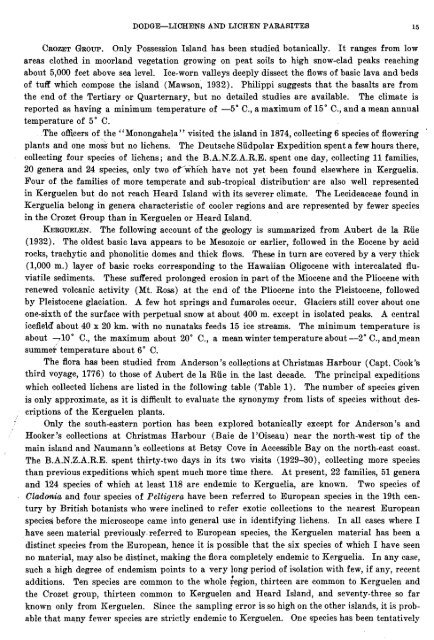Create successful ePaper yourself
Turn your PDF publications into a flip-book with our unique Google optimized e-Paper software.
DODGE--<strong><strong>LICHEN</strong>S</strong> <strong>AND</strong> <strong>LICHEN</strong> <strong>PARASITES</strong> 15<br />
CROZET GROUP. Only Possession Island has been studied botanically. It ranges from low<br />
areas clothed in moorland vegetation growing on peat soils to high snow-clad peaks reaching<br />
about 5,000 feet above sea level. Ice-worn valleys deeply dissect the flows of basic lava and beds<br />
of tuff which compose the island (Mawson, 1932). Philippi suggests that the basalts are from<br />
the end of the Tertiary or Quarternary, but no detailed studies are available. The climate is<br />
reported as having a minimum temperature of -5" C., a maximum of 15" C., and a mean annual<br />
temperature of 5" C.<br />
The oficers of the "Monongahela" visited the island in 1874, collecting 6 species of flowering '<br />
plants and one moss but no lichens. The Deutsche Siidpolar Expedition spent a few hours there,<br />
collecting four species of lichens; and the B.A.N.Z.A.R.E. spent one day, collecting 11 families,<br />
20 genera and 24 species, only two &which have not yet been found elsewhere in Kerguelia.<br />
Four of the families of more temperate and sub-tropical distribution. are also well represented<br />
in Kerguelen but do not reach Heard Island with its severer climate. The Lecideaceae found in<br />
Kerguelia belong in genera characteristic of cooler regions and are represented by fewer species<br />
in the Crozet Group than in Kerguelen or Heard Island.<br />
KEROUELEN. The following account of the geology is summarized from Aubert de la Riie<br />
(1932). The oldest basic lava appears to be Mesozoic or earlier, followed in the Eocene by acid<br />
rocks, trachytic and phonolitic domes and thick flows. These in turn are covered by a very thick<br />
(1,000 m.) layer of basic rocks corresponding to the Hawaiian Oligocene with intercalated fluviatile<br />
sediments. These suffered prolonged erosion in part of the Miocene and the Pliocene with<br />
renewed volcanic activity (Mt. Ross) at the end of the Pliocene into the Pleistocene, followed<br />
by Pleistocene glaciation. A few hot springs and fumaroles occur. Glaciers still cover about one<br />
one-sixth of the surface with perpetual snow at about 400 m. except in isolated peaks. A central<br />
icefield about 40 x 20 km. with no nunataks feeds 15 ice streams. The minimum temperature is<br />
about -10" C., the maximum about 20" C., a mean winter temperature about -2" C., andamean<br />
summet temperature about 6" C.<br />
The flora has been studied from Anderson's collections at Christmas Harbour (Capt. Cook's<br />
third voyage, 1776) to those of Aubert de la Rue in the last decade. The principal expeditions<br />
which collected lichens are listed in the following table (Table 1). The number of species given<br />
is only approximate, as it is difficult to evaluate the synonymy from lists of species without descriptions<br />
of the Kerguelen plants.<br />
Only the south-eastern portion has been explored botanically except for Anderson's and<br />
Hooker's collections at Christmas Harbour (Baie de llOiseau) near the north-west tip of the<br />
main island and Naumann's collections at Betsy Cove in Accessible Bay on the north-east coast.<br />
The B.A.N.Z.A.R.E. spent thirty-two days in its two visits (1929-30), collecting more species<br />
than previous expeditions which spent much more time there. At present, 22 families, 51 genera<br />
and 124 species of which at least 118 are endemic to Kerguelia, are known. Two species of<br />
Cladmia and four species of Peltigera have been referred to European species in the 19th century<br />
by British botanists who were inclined to refer exotic collections to the nearest European<br />
species before the microscope came into general use in identifying lichens. In all cases where I<br />
have seen material previously referred to European species, the Kerguelen material has been a<br />
distinct species from the European, hence it is possible that the six species of which I have seen<br />
no material, may also be distinct, making the flora completely endemic to Kerguelia. In any case,<br />
such a high degree of endemism points to a very long period of isolation with few, if any, recent<br />
additions. Ten species are common to the whole ;egion, thirteen are common to Kerguelen and<br />
the Crozet group, thirteen common to Kerguelen and Heard Island, and seventy-three so far<br />
known only from Iierguelen. Since the sampling error is so high on the other islands, it is probable<br />
that many fen-el- species are strictly endemic to Kerguelen. One species has been tentatively

















